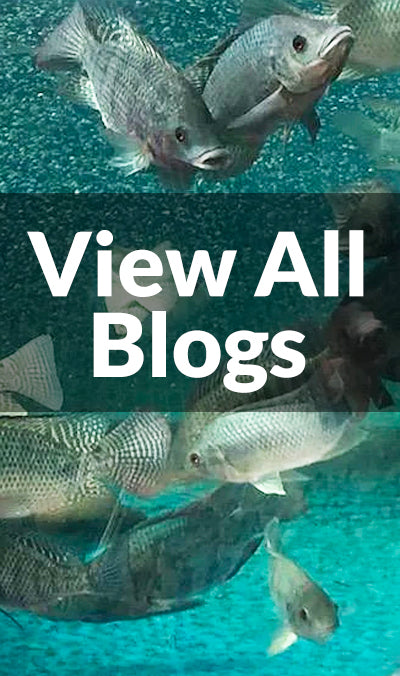Noticing yellowing leaf edges, burnt-looking tips, or weak fruit growth in your aquaponics plants?That could be a potassium deficiency, one of the most common nutrient imbalances beginners face, and one of the easiest to correct once you understand the signs.
In simple terms: potassium is essential for plant strength, fruit development, and stress resistance. But unlike nitrogen, it doesn’t always show up in high enough levels from fish waste alone, which means even healthy-looking systems can gradually run low without the grower realizing it.
The good news: fixing potassium deficiency is straightforward, it usually just involves confirming the symptoms, adding a safe, aquaponics-approved potassium source, and monitoring your plants over the next few days to track recovery.
 Want to actually see how it’s done in a live aquaponics setup? This 5-hour premium Aquaponics Video Course includes full walkthroughs on diagnosing and dosing potassium safely.
Want to actually see how it’s done in a live aquaponics setup? This 5-hour premium Aquaponics Video Course includes full walkthroughs on diagnosing and dosing potassium safely.
Why Potassium Matters in Aquaponics
Potassium (K) is one of the three primary macronutrients plants need, right alongside nitrogen (N) and phosphorus (P). But while most aquaponics growers pay close attention to nitrogen and pH, potassium deficiency often goes unnoticed until plant health begins to visibly decline.
Here’s why potassium is essential in aquaponics:
- It drives water and nutrient movement inside the plant which is critical for overall vigor and growth.
- It enhances fruiting and flowering, low potassium is a leading cause of poor tomato, cucumber, or pepper yield.
- It boosts disease and stress resistance, potassium-deficient plants struggle with heat stress, pests, and infections.
- Unlike nitrogen, fish waste alone typically doesn’t supply enough potassium especially in fruiting or heavily planted systems.
Think of potassium as the plant’s circulatory and immune system combined. When levels drop, the damage is subtle at first, lower yields, slower growth, leaves losing color from the edges inward, but if ignored, it can eventually lead to crop failure, not just poor performance.

How to Recognize Potassium Deficiency in Aquaponics
Potassium deficiency tends to show up first on older leaves, and unlike nitrogen, which causes overall yellowing, potassium shows very distinct visual patterns, especially around the leaf edges.
Here are the most common signs to look for:
- Yellowing or fading along the edges of older leaves, starting at the margins, not the veins
- Brown, crispy, or “burnt” leaf tips, margins may look scorched or dehydrated
- Interveinal chlorosis, leaf edges fade but veins remain partially green
- Weak stems and poor fruit/flower development, tomatoes, peppers, basil especially affected
- Slow recovery after stress, plants struggle with heat or pests more than usual
How to tell it’s potassium, and not calcium or magnesium:
- Potassium: edge burn or yellowing, starting from outer margins inward
- Magnesium:yellowing between the veins (but edges stay green)
- Calcium: twisted or deformed new leaves first, not old ones
How to Confirm Potassium Deficiency
While visual symptoms are a strong indicator, it’s still important to confirm potassium deficiency before adding any supplements, because misdiagnosing nutrients is one of the fastest ways beginners accidentally stress their fish or trigger nutrient imbalance.
Here are the safest and most practical ways to confirm it:
Step 1: Visual and Context Check (Good for Fast Validation)
Ask yourself:
- Are the symptoms starting on older leaves first?
- Are the edges fading or burning, rather than the center or new growth?
- Is the system currently fruiting or supporting fast-growing leafy crops?
Step 2: EC Trend Check (Supportive Clue, Not a Standalone Test)
-
Stable or falling EC over time while plants are actively fruiting can suggest plants are absorbing potassium faster than it’s being replenished.
Step 3: Tissue Test (Best confirmation, optional but highly accurate)
- Simply clip the 3rd or 4th fully-developed leaf from the top.
- Send to a local ag lab for plant tissue analysis (not water testing).
- Optimal range for healthy leafy crops is typically 3–5% potassium in tissue dry weight.
Step 4: Rule Out Lookalikes (Quick Elimination)
- Twisted NEW leaves first?: Likely calcium, not potassium.
- Veins stay green but space between turns yellow?: Likely magnesium.
- Only happens in extreme heat midday?: Could be temporary heat stress, not deficiency.
Safe Ways to Correct Potassium Deficiency in Aquaponics
Once you’re confident potassium is the issue, the next priority is correcting it safely, meaning improving plant health without shocking the fish or destabilizing water chemistry.
Here are the best and safest correction methods, ranked from low-risk to stronger intervention:
Option 1: Adjust Fish Feed (Natural but slow)
If you're using low-mineral or low-quality fish feed, upgrading to a premium, plant-nutrient-balanced aquaculture feed can gradually improve potassium levels over time.
Best for: long-term maintenance, not emergency rescue.
Option 2: Add a Fish-Safe Potassium Supplement (Most Common and Effective)
Common safe options (always start small and dissolve before adding):
- Potassium Sulfate (K₂SO₄): ideal for leafy greens, doesn't affect nitrates
- Potassium Carbonate / Potassium Bicarbonate: raises both potassium & pH, useful if your system is acidic
- Potassium Nitrate (KNO₃): adds nitrate too (use with caution in high-nitrate systems)
Option 3: Foliar Spray (Fastest Plant Rescue, but temporary)
Mix a very mild potassium solution and spray directly onto leaf surfaces in the early morning or evening.
- Works fast because it bypasses the root system
- Great for fruiting crops like tomatoes and peppers that need immediate support
Important: foliar spray helps buy time, it does NOT solve the root deficiency long-term.
Option 4: Mineral Buffer Basket or Slow-Release Media (Preventive Strategy)
Place crushed mineral rock or potassium-rich amendments in a mesh bag within the sump or filter area. Slow-release, excellent for stabilizing long-term nutrient levels.

How to Prevent Potassium Deficiency Long-Term
Once you’ve corrected potassium deficiency, the goal is to prevent it from coming back, especially if you’re running fruiting plants, heavy production cycles, or long-term systems.
Here’s a simple but highly effective prevention strategy used by serious aquaponics growers:
1. Follow a Simple Nutrient Monitoring Routine
- Weekly: Quick visual & leaf health check (edges, color, growth rate)
- Monthly: EC + system health review (to spot nutrient draw-down trends)
- Quarterly:Optional tissue test or mineral balance check (for high-value crops)
2. Optimize Fish Feed Quality
Switch to high-grade aquaculture feed designed for plant nutrient support, not just fish growth.
Premium feeds naturally reduce how often you need to add supplements.
3. Add a Slow-Release Mineral Source (Hands-Off Buffering)
Place crushed mineral rock or potassium-rich media in a mesh bag inside your sump or biofilter zone., Acts like a natural nutrient reservoir, consistently releasing K over time.
4. Anticipate Higher Demand During Fruiting Cycles
Tomatoes, peppers, strawberries, and cucumbers spike their potassium needs when they begin fruiting.
Best practice: micro-dose potassium weekly during flowering or fruiting, instead of waiting for deficiency to show up.
Regular Monitoring and Maintenance
Once your aquaponics system is up and running, consistency is everything. Even the most well-designed setups can fail if left unmanaged, which is why regular monitoring isn’t optional, it’s your system’s life support.
Here’s what beginners should check on a weekly or daily basis:
1. Water Quality Parameters
This is the health report card of your system.
- pH level: Ideally between 6.8–7.2
- Ammonia:Should always stay below 0.5 ppm
- Nitrite: Should always be near 0 ppm
- Nitrate:20–80 ppm is ideal (higher means your plants need to catch up)
A basic test kit like API Freshwater Master Kit is more than enough to start.
2. Water Level and Top-Ups
Natural evaporation happens, especially indoors with grow lights.
Use only dechlorinated water (or treated tap water). Never refill directly with tap water unless treated.
3. Fish Health and Feeding Behavior
Observe before you feed are they active, swimming normally, and eating quickly?
Slow feeding response or unusual floating/sinking behavior means something is off.
4. Plant Growth and Leaf Health
Watch out for signs like:
- Yellowing leaves → likely nutrient imbalance
- Spindly growth → weak lighting or low nutrients
- Pest activity → time to apply organic intervention
5. Equipment Check-Up
- Water pump still strong?
- Air pump bubbling steadily?
- No strange humming or vibration sounds?
One failed pump can crash an entire system overnight, don’t let it surprise you.
Common Problems and How to Fix Them
Even well-maintained aquaponics systems can run into issues, the key is knowing how to recognize warning signs early and apply fast fixes before things spiral. Here are the most common beginner problems and simple solutions you can act on immediately:
Problem #1: Fish Aren’t Eating
Possible causes:
- Water temperature too low or high
- Poor water quality (check ammonia and nitrite immediately)
- Stress from sudden changes
Quick Fix:
Test water parameters. If ammonia or nitrite is above 0.5 ppm, stop feeding and perform a water change (20–30%) using dechlorinated water.
Problem #2: Yellowing Leaves on Plants
Likely cause:Nutrient deficiency or pH too high
Quick Fix:
Test pH: If above 7.4, slowly adjust downward using organic pH-down solution.
For nutrient boost:Add liquid iron (chelated) or seaweed extract which is safe for fish if dosed correctly.
Problem #3: Water Pump Suddenly Stops
Likely cause: Clogged with debris, roots, or biofilm buildup
Quick Fix:
Unplug immediately and clean the pump filter and impeller and reinstall.
Tip: Install a pre-filter sponge to prevent future blockages.
Problem #4: Slow Plant Growth
Likely cause: Too few fish or weak lighting
Quick Fix:
- Add more fish gradually (if ammonia is stable)
- Upgrade to full-spectrum LED grow lights
- Check if grow bed is flooding/draining properly
Problem #5: Rapid Water Evaporation
Common in warm indoor setups
Quick Fix:
Top up more frequently, but ONLY with treated or dechlorinated water.
Bonus: Use a tank cover or shade net to reduce evaporation.
Conclusion
Managing potassium deficiency and aquaponics systems in general, becomes far less stressful once you understand the “why” behind what’s happening.
Now you've learned how to identify, prevent, and correct potassium imbalance, a major milestone in your journey toward a stable, self-sustaining system.
But here’s the honest truth:
- Most beginners fail not because of one big mistake… but because of small, silent issues they didn’t catch soon enough.
- The growers who succeed fastest are the ones who learn to read their system like a language, and take action before things go wrong.
If you're serious about growing healthy plants, fast-growing fish, and a system that practically runs itself, then your next best step is clear:
Ready to Go Deeper?
 Check this 5-hour premium Aquaponics Video Course, a complete, step-by-step training designed to help you:
Check this 5-hour premium Aquaponics Video Course, a complete, step-by-step training designed to help you:
- Avoid system crashes and nutrient mistakes before they even start
- Understand exactly what your system is trying to tell you
- Learn the pro grower secrets for boosting yield without adding complexity
- Build real confidence, so you never feel stuck guessing “what went wrong?”
It’s the perfect next step if you’re ready to stop troubleshooting… and start thriving.






Leave a comment (all fields required)